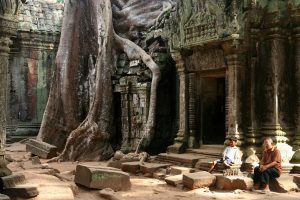Land grabbing has been a hot-button issue in Cambodia ever since the first United Nations peacekeepers arrived in the early 1990s and initiated their first de-mining programs, in a country where quality real estate was in short supply and arguments over ownership were many and heated.
Barely a week passes in which a land dispute – big or small – is not reported. The latest concern is people with livelihoods around the planned Funan Techo Canal, to be dug from Phnom Penh to Kep, while lingering disputes remain at Angkor Wat where up to 40,000 people have been displaced.
Since 1992, the famed temples of Angkor Wat have enjoyed all the rights and privileges that came with their listing by the World Heritage Committee from the U.N.’s Educational Scientific and Cultural Organization, more commonly known as UNESCO.
For years the temples stood at the top of the world’s most desired travel destinations and a tourism boom provided a much-needed cash cow in a country struggling with post-war reconstruction – and as one would expect, Cambodians hoping to scratch out a living moved into the site.
That’s where the biggest problems emerged.
UNESCO does make allowances for people who maintain a traditional lifestyle around its monuments to live onsite; however, that might not include local vendors selling cans of coke, cigarettes, and tourist trinkets. UNESCO has said as much.
When naming Angkor as a World Heritage site UNESCO was clear in stating that people living around core areas of the 162-hectare site “was inappropriate to the preservation and presentation of major archaeological sites.”
A UNESCO report later found that some people living in traditional villages had the right to stay inside the Angkor complex while new settlers did not. That enabled Cambodian authorities to move with their usual belligerence and push thousands to resettle in a relocation site known as Run Ta Ek.
Plots of land, building materials, and two months’ pay were offered to those who moved but by all reports, there’s not much on offer at Run Ta Ek. Families live under tarps, sanitation is inadequate, jobs are non-existent, and it sits a 45-minute drive from the provincial capital, Siem Reap, the gateway to the Angkor temples.
Human rights group Amnesty International has closely followed the dispute and found UNESCO recommendations and Cambodian laws have failed to make clear which settlements were traditional villages. Amnesty also alleged that 40,000 residents had been evicted.
Interviews that the group conducted with more than 100 people found authorities “used threats to force people off their land.” They were then relocated to a “barren relocation site lacking essential services.” Amnesty urged UNESCO to “publicly condemn forced evictions carried out in its name.”
Amnesty’s findings have finally struck a chord with the World Heritage Committee. At its latest meeting in New Delhi last week, the committee focused on “third-party reports concerning possible forced population displacements.”
It recommended dispatching a team to inspect the alleged displacement and rights abuses of people at the Angkor Wat temple complex. That won’t sit well in Phnom Penh, where government officials relish international legitimacy but loathe any form of criticism.
But this is an issue they need to think clearly about. Angkor Wat is not the world’s top tourist destination as it was before the crackdown on political dissent emerged in the late 2010s. COVID-19 then ensured the end of Cambodia’s dream run as a travelers’ paradise.
These days, Angkor Wat does not even rank in the top 10 of the world’s top tourist destinations and the constant stream of negative headlines emanating from the country – ranging from human trafficking and scam compounds to the jailing of political dissidents and rights advocates – don’t help.
It’s an embarrassing fall from grace that can not be negated by shutting down critics, and make no mistake, Amnesty is quite capable of running a campaign to have Angkor Wat removed from UNESCO’s World Heritage list, not unlike the attempt by Greenpeace to have Australia’s Great Barrier Reef removed in 2015.
The Greenpeace bid failed but only after an extraordinary diplomatic effort by the Australian government and a $1.5 billion, 10-year plan to restore the reef’s ecosystem. Cambodia might like to think likewise before UNESCO’s investigators arrive.

































